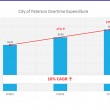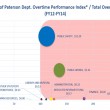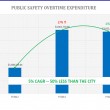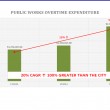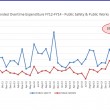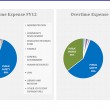Several city departments incurring unsustainable overtime, according councilman’s analysis
By Jayed Rahman
Published: December 1, 2014
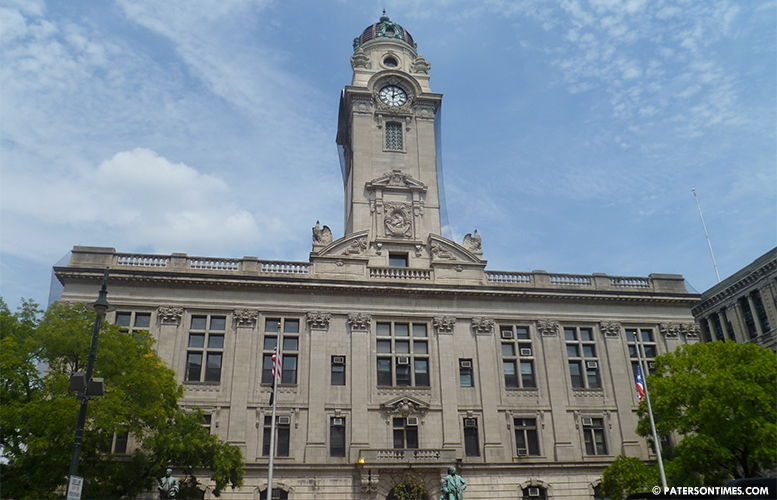
Multiple city departments are on an unsustainable trajectory when it comes to overtime spending, that is one of the findings that was presented before the city council early last week in a presentation by council president Julio Tavarez.
“Of course we’re spending money on overtime, but the problem is that it’s growing every year,” explained Tavarez clicking through slides on an overhead projector on Tuesday evening. The councilman’s slide showed rapid growth in overtime over the three-year period covered in his analysis.
In fiscal year 2012 the city spent $5.02 million in overtime; in fiscal year 2013 the city expended $5.85 million in overtime; in fiscal year 2014 the city exhausted $6.70 million in overtime, according to Tavarez’s chart. The councilman pointed out that from fiscal year 2012 to 2013 the city saw an overtime expenditure increase of 17-percent; furthermore, from fiscal year 2013 to 2014 the city witnessed an overtime expenditure increase of 15-percent.
Tavarez calculated the compound annual growth rate (CAGR) or year over year increase in overtime expenditure discovering a growth rate of 10-percent. “We’re growing 10-percent every year,” said Tavarez. “We’re supposed to cap taxes at 3-percent — overtime is growing at 10-percent.”
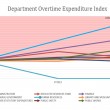
Graph shows general government, finance, and public works outpacing other departments in overtime expenditure.
Taking a deeper look, the councilman found much of the growth in overtime expenditure occurred in three departments: general government, finance, and public works. “General government is growing tremendously,” said Tavarez. “General government is growing a lot, but it’s a small amount.”
General government’s appetite for overtime cost the city $0.07 million between fiscal year 2012-14, an inconsequential amount compared to public safety’s $11.29 million. Growing at only 5-percent annually, public safety overtime actually declined by 1-percent in fiscal year 2014, according to Tavarez’s analysis.
“This is a runaway train because it’s growing so fast,” remarked Tavarez discussing the exponential growth in overtime in the finance department. The department’s overtime expenditure grew 32-percent every year from fiscal year 2012. The councilman cautioned that, although the growth is explosive, the amount of money involved is only $120,000. Tavarez said the city needs to “watch out” for this department.
The city’s public works department is also undergoing explosive growth in overtime, said Tavarez. “DPW is growing, not only really fast, but the money, the dollar value, is very high: it went from $1.3 million in fiscal year 2012 to $1.5 million in fiscal year 2013 and $2.3 million in fiscal year 2014,” said the councilman.
From fiscal year 2013 to 2014, public works grew by a whopping 53-percent. Public works’ overtime is growing at an annual rate of 20-percent. The councilman further examined public works and public safety’s overtime expenditure in search of seasonal fluctuations; surprisingly, the councilman found little seasonal change in overtime expenditure.
Business administrator Nellie Pou attributed excessive police overtime during the summer to police investigations, suggesting a general correlation between public safety overtime and crime heavy summer months. Pou was not alone, during his tenure Charles Thomas, former city business administrator, attributed excessive public works overtime to major snowstorms. The problem: three years of data does not bear out the assertions.
If snow storms caused increases in overtime in public works there would be spikes during the winter months, Tavarez found none. If increase in crime during the summer resulted in increased police overtime, then there would be spikes in June, July, and August, but no such increase is apparent in monthly public safety overtime expenditure data.
“There’s no trend,” said Tavarez. “There is no seasonality. We really can’t tell if the overtime goes up in August and then goes down because it spikes everywhere.”
During the recent budget hearings, council members found departments incorrectly categorizing expenses. Tavarez suggested that may be a reason for the lack of seasonality: “it’s just really bad reporting.”
There was a spike in overtime for public works in June 2014. “They spent almost $800,000 in overtime in one month,” said Tavarez.
The councilman urged the administration to look into how the department managed to spend $773,186 in overtime in a single month, just days before the fiscal year came to a close.
Tavarez also highlighted an overall picture of the city’s overtime expenditure showing much of the savings in public safety is being expended in public works. In fiscal year 2012 public works incurred 27-percent of all city overtime; in fiscal year 2014 public works incurred 35-percent of all overtime.
Public safety, which was eating up 68-percent of all city overtime in fiscal year 2012, saw a significant reduction in fiscal year 2014. Overtime for public safety stood at 59-percent in fiscal year 2014.
Reflecting on the lack of seasonal fluctuation in the date, Tavarez said the data is unreliable. “The data we have is suspect,” said Tavarez. “I don’t have too much confidence that this was reported correctly because I should be seeing a spike in public safety overtime in June because of the calls for service.”
Tavarez said if the data was accurate it would allow the city to adequately staff to reduce overtime during peak months.
